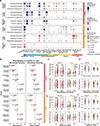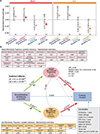Microbial colonization programs are structured by breastfeeding and guide healthy respiratory development
- PMID: 39303691
- PMCID: PMC11531244
- DOI: 10.1016/j.cell.2024.07.022
Microbial colonization programs are structured by breastfeeding and guide healthy respiratory development
Abstract
Breastfeeding and microbial colonization during infancy occur within a critical time window for development, and both are thought to influence the risk of respiratory illness. However, the mechanisms underlying the protective effects of breastfeeding and the regulation of microbial colonization are poorly understood. Here, we profiled the nasal and gut microbiomes, breastfeeding characteristics, and maternal milk composition of 2,227 children from the CHILD Cohort Study. We identified robust colonization patterns that, together with milk components, predict preschool asthma and mediate the protective effects of breastfeeding. We found that early cessation of breastfeeding (before 3 months) leads to the premature acquisition of microbial species and functions, including Ruminococcus gnavus and tryptophan biosynthesis, which were previously linked to immune modulation and asthma. Conversely, longer exclusive breastfeeding supports a paced microbial development, protecting against asthma. These findings underscore the importance of extended breastfeeding for respiratory health and highlight potential microbial targets for intervention.
Keywords: asthma; breastfeeding; computational biology; development; early life; gut microbiome; human milk; machine learning; microbial dynamics; microbiome development; nasal microbiome; respiratory health.
Copyright © 2024 The Authors. Published by Elsevier Inc. All rights reserved.
Conflict of interest statement
Declaration of interests M.B.A. receives research funding from the Canadian and US governments, the Bill and Melinda Gates Foundation, and the Garfield Weston Foundation. She holds a Canada Research Chair in Early Nutrition and the Developmental Origins of Health and Disease and is a fellow of the CIFAR Humans and the Microbiome program. She has consulted for DSM Nutritional Products, serves on the scientific advisory board for TinyHealth, and has received speaking honoraria from Prolacta Biosciences. She has contributed without remuneration to online courses on breast milk and the infant microbiome produced by Microbiome Courses. L.B. receives research funding from the United States National Institutes of Health and the Bill and Melinda Gates Foundation. L.B. is the UC San Diego Chair of Collaborative Human Milk Research endowed by the Family Larsson-Rosenquist Foundation in Switzerland. V.B. is currently an employee of F. Hoffman-La Roche Ltd.; however, the published work was done prior to her employment and does not involve/promote any of Roche’s materials or point of view.
Figures







References
-
- Abrams GD, Bauer H, and Sprinz H (1963). Influence of the normal flora on mucosal morphology and cellular renewal in the ileum. A comparison of germ-free and conventional mice. Lab. Invest. 12, 355–364. - PubMed
-
- Bouskra D, Brézillon C, Bérard M, Werts C, Varona R, Boneca IG, and Eberl G (2008). Lymphoid tissue genesis induced by commensals through NOD1 regulates intestinal homeostasis. Nature 456, 507–510. - PubMed
-
- Derrien M, Alvarez A-S, and de Vos WM (2019). The Gut Microbiota in the First Decade of Life. Trends Microbiol. 27, 997–1010. - PubMed
MeSH terms
Grants and funding
LinkOut - more resources
Full Text Sources
Medical

